Managing Change: External Consultant, Activities, Diagnosis Report
VerifiedAdded on 2022/09/22
|16
|3473
|29
Report
AI Summary
This report examines the strategic advantages of employing an external consultant to manage organizational change, particularly in situations where internal perspectives diverge. It explores the benefits of external consultants, such as their ability to navigate role ambiguity, build employee trust, and wield sufficient power to implement change strategies effectively, leading to better decision-making. The report outlines five key activities that change agents must undertake: initiating inquiry, investigating best practices, identifying themes, envisioning a preferred future, and designing implementation strategies. Furthermore, it discusses the challenges encountered at each stage of the change process, emphasizing the critical role of diagnosis and feedback in facilitating organizational change. The study uses a five-stage model of Change management within the organization based on appreciative inquiry and the action research model of Kurt Lewin, focusing on what is working and not on what is not working.
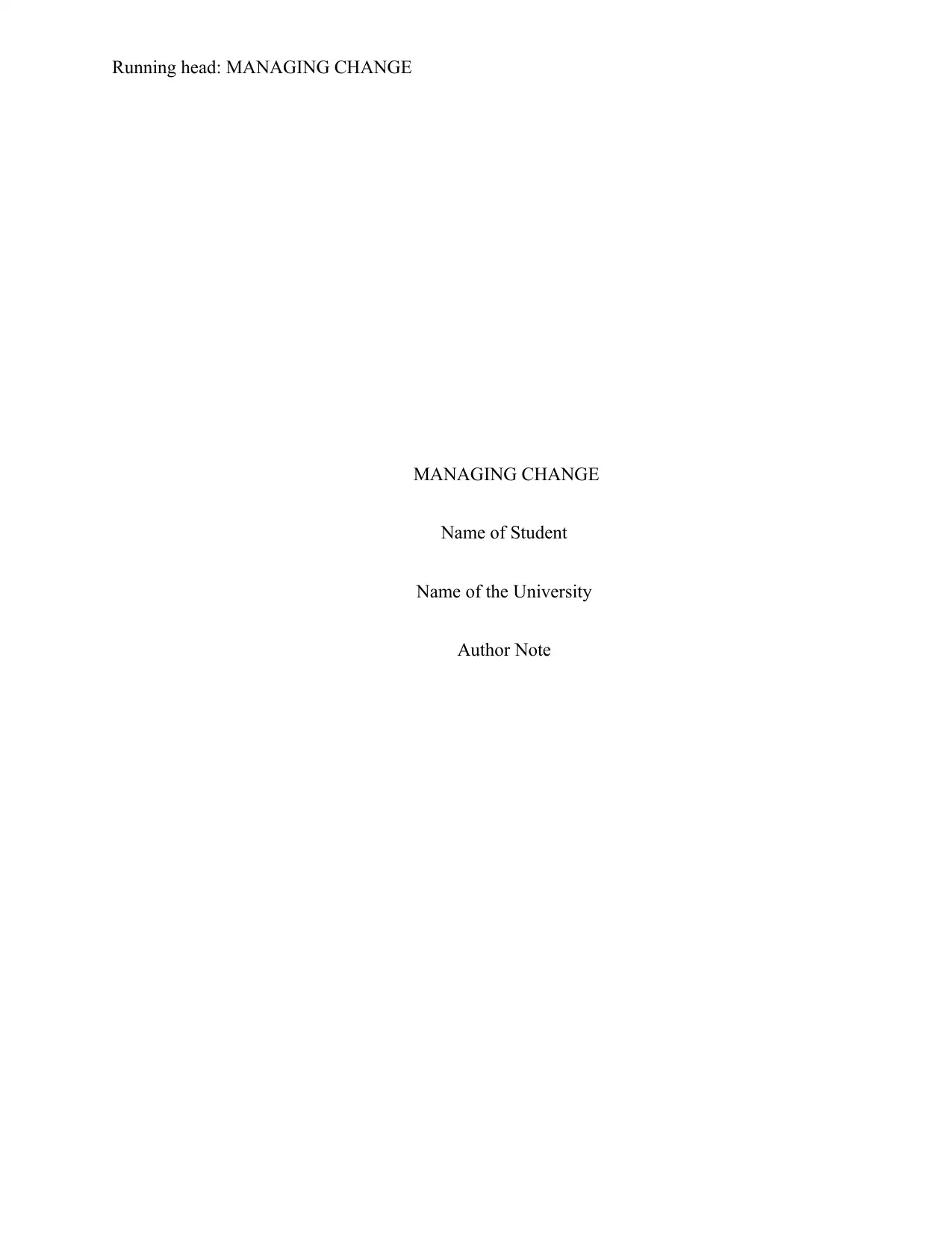
Running head: MANAGING CHANGE
MANAGING CHANGE
Name of Student
Name of the University
Author Note
MANAGING CHANGE
Name of Student
Name of the University
Author Note
Paraphrase This Document
Need a fresh take? Get an instant paraphrase of this document with our AI Paraphraser
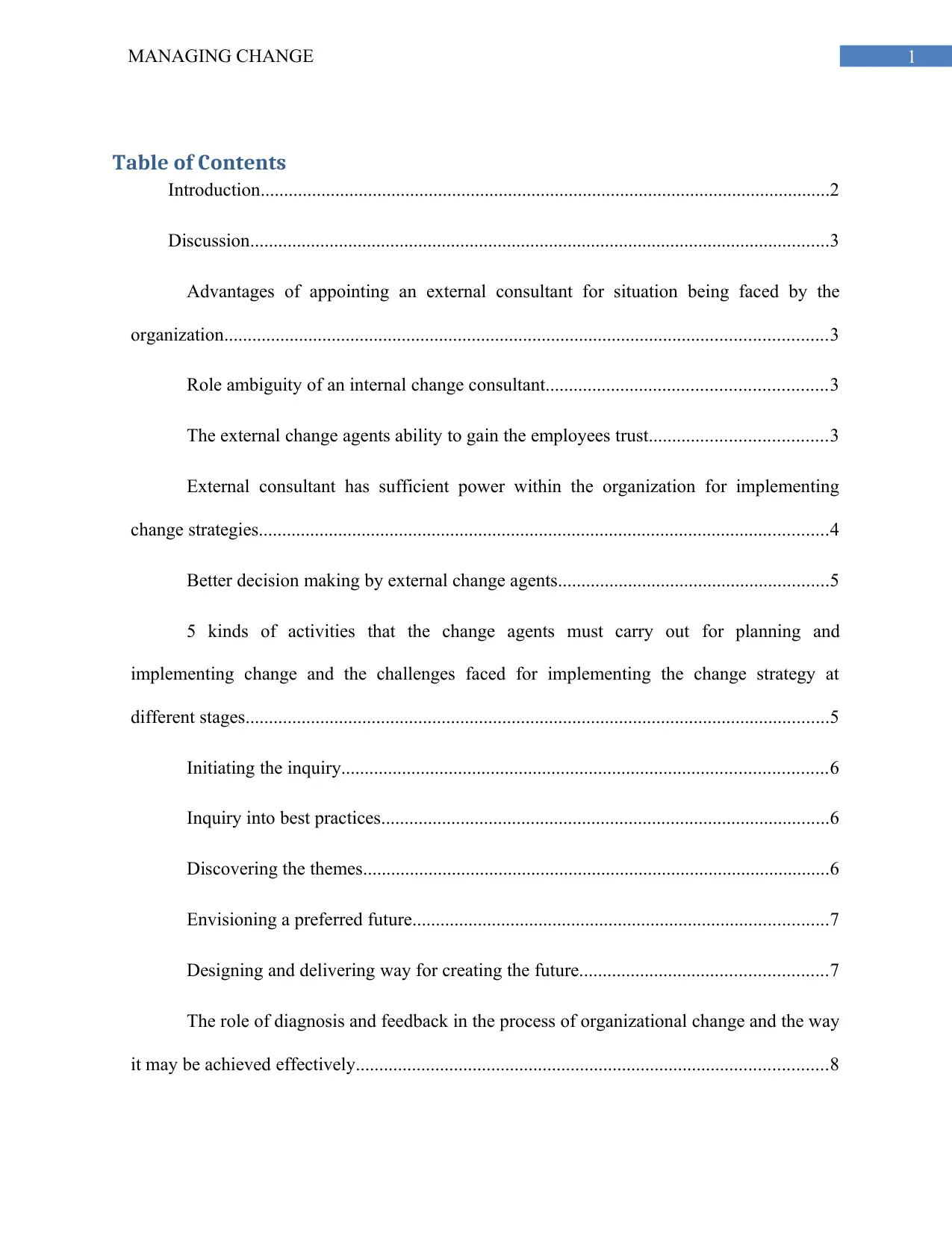
1MANAGING CHANGE
Table of Contents
Introduction..........................................................................................................................2
Discussion............................................................................................................................3
Advantages of appointing an external consultant for situation being faced by the
organization.................................................................................................................................3
Role ambiguity of an internal change consultant............................................................3
The external change agents ability to gain the employees trust......................................3
External consultant has sufficient power within the organization for implementing
change strategies..........................................................................................................................4
Better decision making by external change agents..........................................................5
5 kinds of activities that the change agents must carry out for planning and
implementing change and the challenges faced for implementing the change strategy at
different stages.............................................................................................................................5
Initiating the inquiry........................................................................................................6
Inquiry into best practices................................................................................................6
Discovering the themes....................................................................................................6
Envisioning a preferred future.........................................................................................7
Designing and delivering way for creating the future.....................................................7
The role of diagnosis and feedback in the process of organizational change and the way
it may be achieved effectively.....................................................................................................8
Table of Contents
Introduction..........................................................................................................................2
Discussion............................................................................................................................3
Advantages of appointing an external consultant for situation being faced by the
organization.................................................................................................................................3
Role ambiguity of an internal change consultant............................................................3
The external change agents ability to gain the employees trust......................................3
External consultant has sufficient power within the organization for implementing
change strategies..........................................................................................................................4
Better decision making by external change agents..........................................................5
5 kinds of activities that the change agents must carry out for planning and
implementing change and the challenges faced for implementing the change strategy at
different stages.............................................................................................................................5
Initiating the inquiry........................................................................................................6
Inquiry into best practices................................................................................................6
Discovering the themes....................................................................................................6
Envisioning a preferred future.........................................................................................7
Designing and delivering way for creating the future.....................................................7
The role of diagnosis and feedback in the process of organizational change and the way
it may be achieved effectively.....................................................................................................8
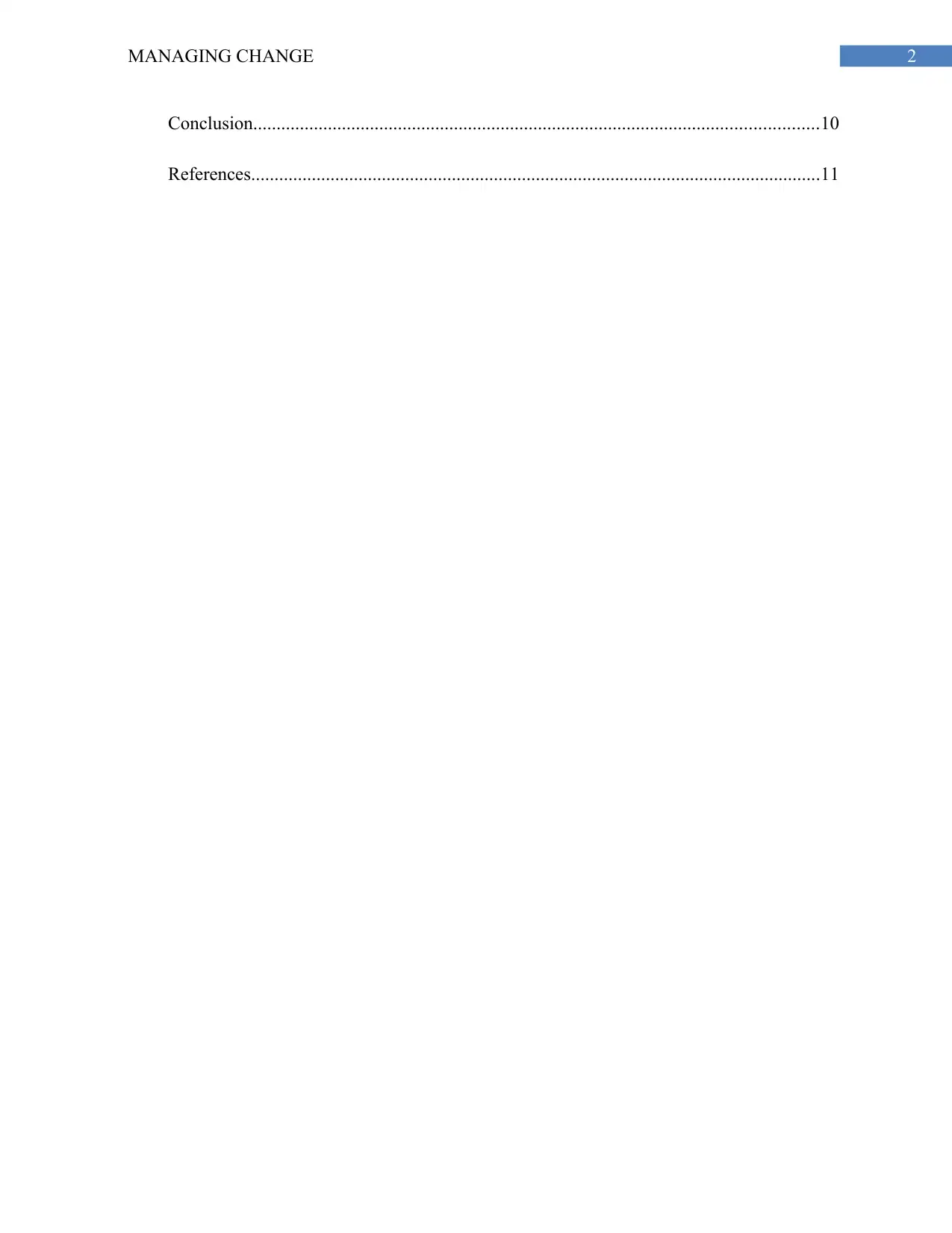
2MANAGING CHANGE
Conclusion.........................................................................................................................10
References..........................................................................................................................11
Conclusion.........................................................................................................................10
References..........................................................................................................................11
⊘ This is a preview!⊘
Do you want full access?
Subscribe today to unlock all pages.

Trusted by 1+ million students worldwide
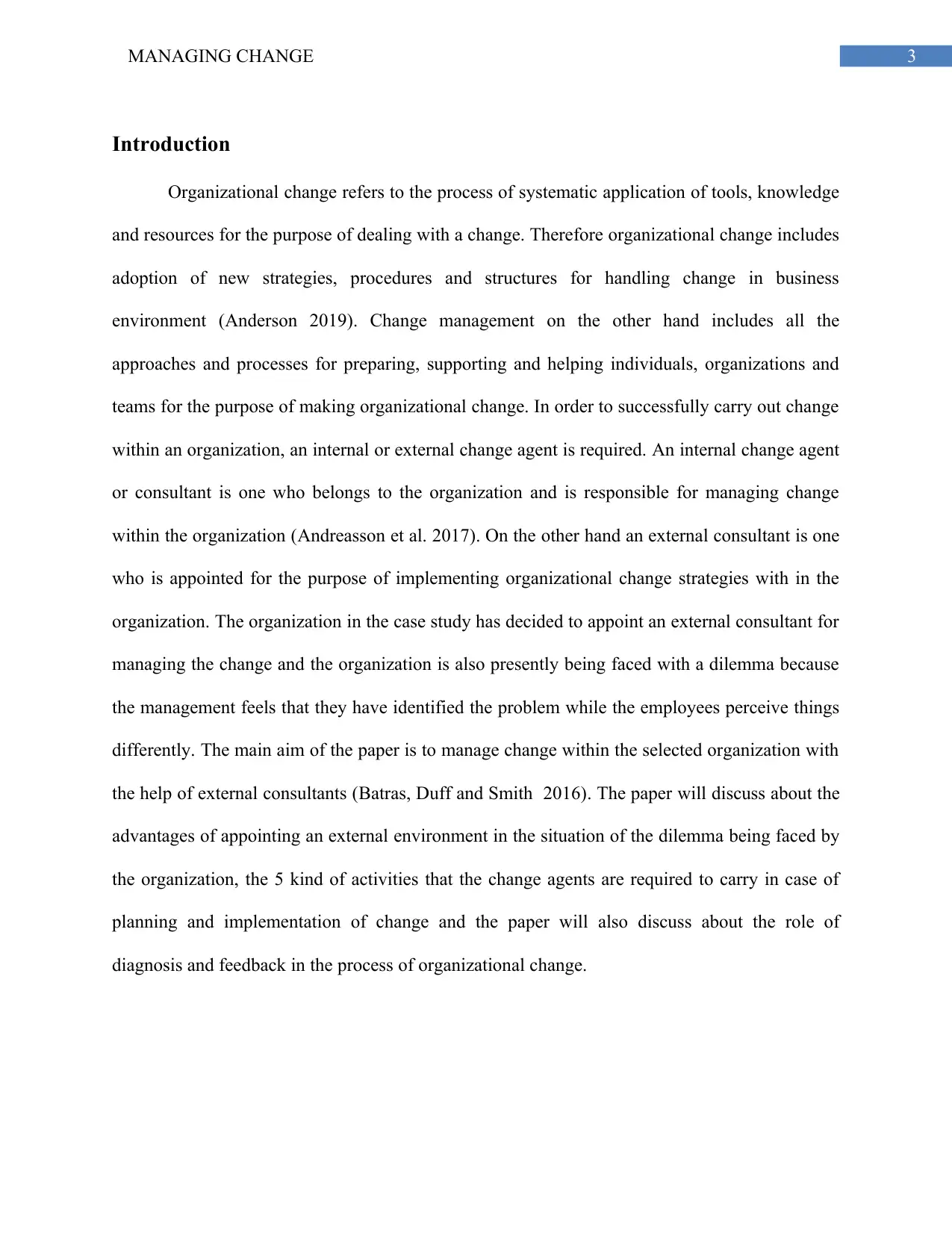
3MANAGING CHANGE
Introduction
Organizational change refers to the process of systematic application of tools, knowledge
and resources for the purpose of dealing with a change. Therefore organizational change includes
adoption of new strategies, procedures and structures for handling change in business
environment (Anderson 2019). Change management on the other hand includes all the
approaches and processes for preparing, supporting and helping individuals, organizations and
teams for the purpose of making organizational change. In order to successfully carry out change
within an organization, an internal or external change agent is required. An internal change agent
or consultant is one who belongs to the organization and is responsible for managing change
within the organization (Andreasson et al. 2017). On the other hand an external consultant is one
who is appointed for the purpose of implementing organizational change strategies with in the
organization. The organization in the case study has decided to appoint an external consultant for
managing the change and the organization is also presently being faced with a dilemma because
the management feels that they have identified the problem while the employees perceive things
differently. The main aim of the paper is to manage change within the selected organization with
the help of external consultants (Batras, Duff and Smith 2016). The paper will discuss about the
advantages of appointing an external environment in the situation of the dilemma being faced by
the organization, the 5 kind of activities that the change agents are required to carry in case of
planning and implementation of change and the paper will also discuss about the role of
diagnosis and feedback in the process of organizational change.
Introduction
Organizational change refers to the process of systematic application of tools, knowledge
and resources for the purpose of dealing with a change. Therefore organizational change includes
adoption of new strategies, procedures and structures for handling change in business
environment (Anderson 2019). Change management on the other hand includes all the
approaches and processes for preparing, supporting and helping individuals, organizations and
teams for the purpose of making organizational change. In order to successfully carry out change
within an organization, an internal or external change agent is required. An internal change agent
or consultant is one who belongs to the organization and is responsible for managing change
within the organization (Andreasson et al. 2017). On the other hand an external consultant is one
who is appointed for the purpose of implementing organizational change strategies with in the
organization. The organization in the case study has decided to appoint an external consultant for
managing the change and the organization is also presently being faced with a dilemma because
the management feels that they have identified the problem while the employees perceive things
differently. The main aim of the paper is to manage change within the selected organization with
the help of external consultants (Batras, Duff and Smith 2016). The paper will discuss about the
advantages of appointing an external environment in the situation of the dilemma being faced by
the organization, the 5 kind of activities that the change agents are required to carry in case of
planning and implementation of change and the paper will also discuss about the role of
diagnosis and feedback in the process of organizational change.
Paraphrase This Document
Need a fresh take? Get an instant paraphrase of this document with our AI Paraphraser
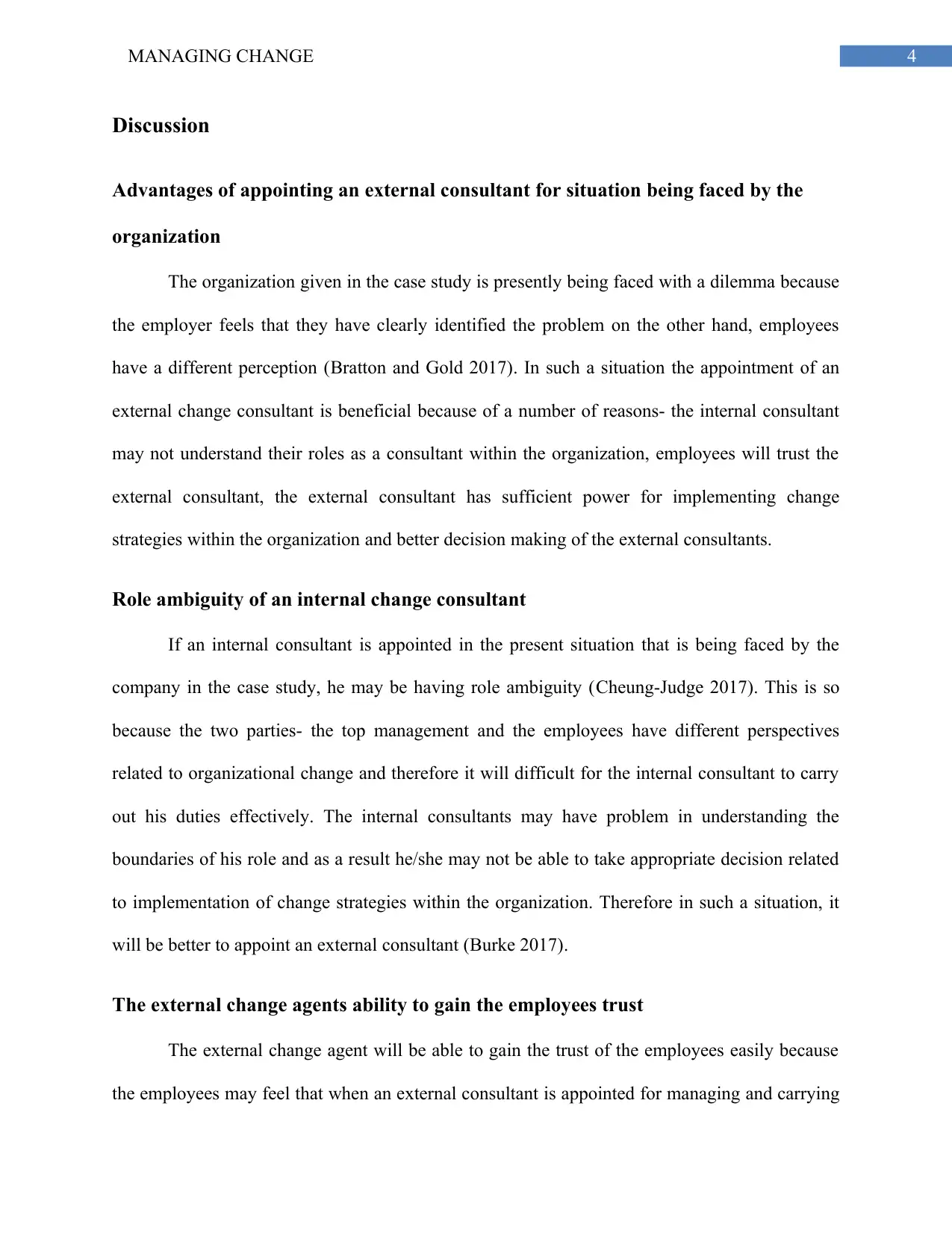
4MANAGING CHANGE
Discussion
Advantages of appointing an external consultant for situation being faced by the
organization
The organization given in the case study is presently being faced with a dilemma because
the employer feels that they have clearly identified the problem on the other hand, employees
have a different perception (Bratton and Gold 2017). In such a situation the appointment of an
external change consultant is beneficial because of a number of reasons- the internal consultant
may not understand their roles as a consultant within the organization, employees will trust the
external consultant, the external consultant has sufficient power for implementing change
strategies within the organization and better decision making of the external consultants.
Role ambiguity of an internal change consultant
If an internal consultant is appointed in the present situation that is being faced by the
company in the case study, he may be having role ambiguity (Cheung-Judge 2017). This is so
because the two parties- the top management and the employees have different perspectives
related to organizational change and therefore it will difficult for the internal consultant to carry
out his duties effectively. The internal consultants may have problem in understanding the
boundaries of his role and as a result he/she may not be able to take appropriate decision related
to implementation of change strategies within the organization. Therefore in such a situation, it
will be better to appoint an external consultant (Burke 2017).
The external change agents ability to gain the employees trust
The external change agent will be able to gain the trust of the employees easily because
the employees may feel that when an external consultant is appointed for managing and carrying
Discussion
Advantages of appointing an external consultant for situation being faced by the
organization
The organization given in the case study is presently being faced with a dilemma because
the employer feels that they have clearly identified the problem on the other hand, employees
have a different perception (Bratton and Gold 2017). In such a situation the appointment of an
external change consultant is beneficial because of a number of reasons- the internal consultant
may not understand their roles as a consultant within the organization, employees will trust the
external consultant, the external consultant has sufficient power for implementing change
strategies within the organization and better decision making of the external consultants.
Role ambiguity of an internal change consultant
If an internal consultant is appointed in the present situation that is being faced by the
company in the case study, he may be having role ambiguity (Cheung-Judge 2017). This is so
because the two parties- the top management and the employees have different perspectives
related to organizational change and therefore it will difficult for the internal consultant to carry
out his duties effectively. The internal consultants may have problem in understanding the
boundaries of his role and as a result he/she may not be able to take appropriate decision related
to implementation of change strategies within the organization. Therefore in such a situation, it
will be better to appoint an external consultant (Burke 2017).
The external change agents ability to gain the employees trust
The external change agent will be able to gain the trust of the employees easily because
the employees may feel that when an external consultant is appointed for managing and carrying
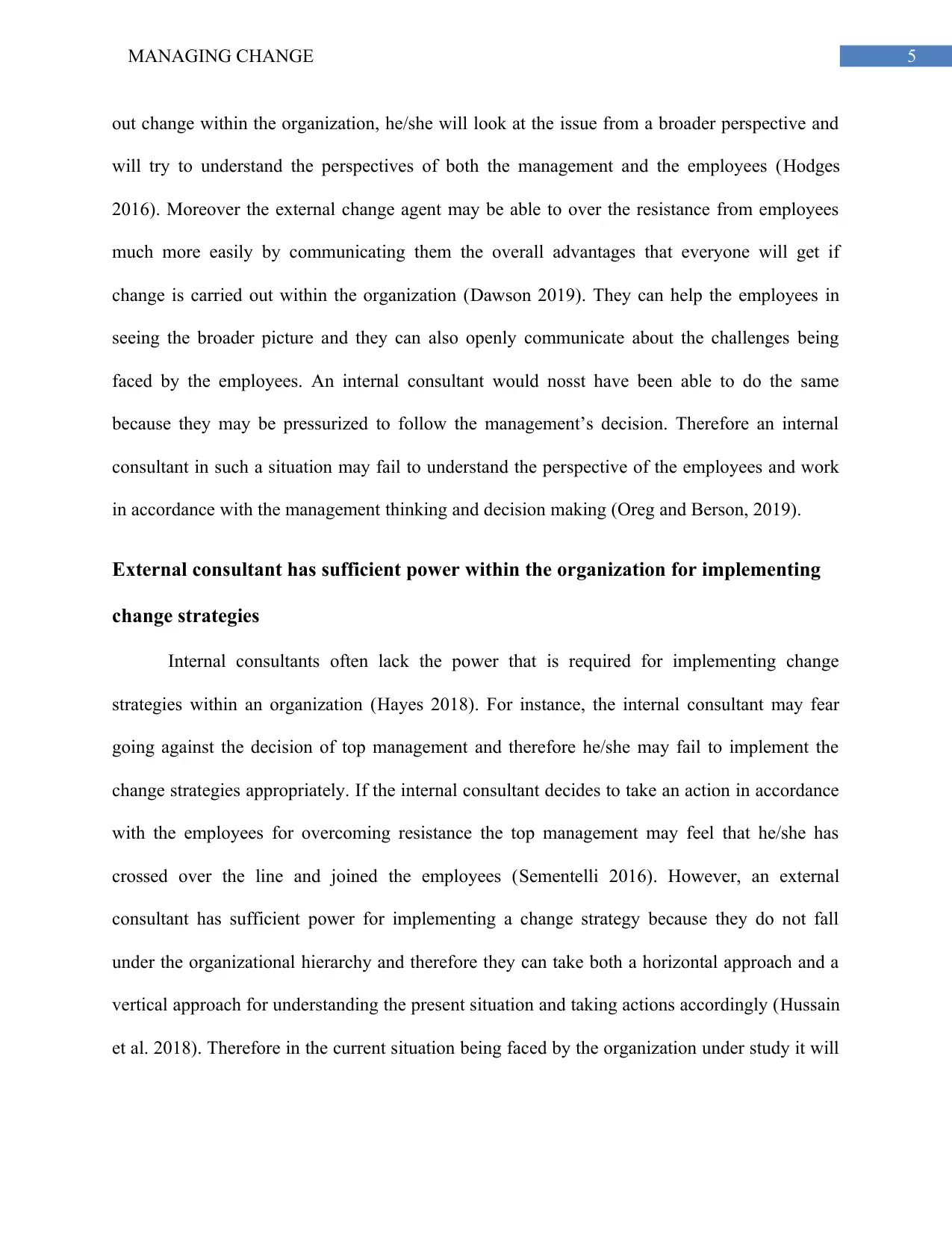
5MANAGING CHANGE
out change within the organization, he/she will look at the issue from a broader perspective and
will try to understand the perspectives of both the management and the employees (Hodges
2016). Moreover the external change agent may be able to over the resistance from employees
much more easily by communicating them the overall advantages that everyone will get if
change is carried out within the organization (Dawson 2019). They can help the employees in
seeing the broader picture and they can also openly communicate about the challenges being
faced by the employees. An internal consultant would nosst have been able to do the same
because they may be pressurized to follow the management’s decision. Therefore an internal
consultant in such a situation may fail to understand the perspective of the employees and work
in accordance with the management thinking and decision making (Oreg and Berson, 2019).
External consultant has sufficient power within the organization for implementing
change strategies
Internal consultants often lack the power that is required for implementing change
strategies within an organization (Hayes 2018). For instance, the internal consultant may fear
going against the decision of top management and therefore he/she may fail to implement the
change strategies appropriately. If the internal consultant decides to take an action in accordance
with the employees for overcoming resistance the top management may feel that he/she has
crossed over the line and joined the employees (Sementelli 2016). However, an external
consultant has sufficient power for implementing a change strategy because they do not fall
under the organizational hierarchy and therefore they can take both a horizontal approach and a
vertical approach for understanding the present situation and taking actions accordingly (Hussain
et al. 2018). Therefore in the current situation being faced by the organization under study it will
out change within the organization, he/she will look at the issue from a broader perspective and
will try to understand the perspectives of both the management and the employees (Hodges
2016). Moreover the external change agent may be able to over the resistance from employees
much more easily by communicating them the overall advantages that everyone will get if
change is carried out within the organization (Dawson 2019). They can help the employees in
seeing the broader picture and they can also openly communicate about the challenges being
faced by the employees. An internal consultant would nosst have been able to do the same
because they may be pressurized to follow the management’s decision. Therefore an internal
consultant in such a situation may fail to understand the perspective of the employees and work
in accordance with the management thinking and decision making (Oreg and Berson, 2019).
External consultant has sufficient power within the organization for implementing
change strategies
Internal consultants often lack the power that is required for implementing change
strategies within an organization (Hayes 2018). For instance, the internal consultant may fear
going against the decision of top management and therefore he/she may fail to implement the
change strategies appropriately. If the internal consultant decides to take an action in accordance
with the employees for overcoming resistance the top management may feel that he/she has
crossed over the line and joined the employees (Sementelli 2016). However, an external
consultant has sufficient power for implementing a change strategy because they do not fall
under the organizational hierarchy and therefore they can take both a horizontal approach and a
vertical approach for understanding the present situation and taking actions accordingly (Hussain
et al. 2018). Therefore in the current situation being faced by the organization under study it will
⊘ This is a preview!⊘
Do you want full access?
Subscribe today to unlock all pages.

Trusted by 1+ million students worldwide
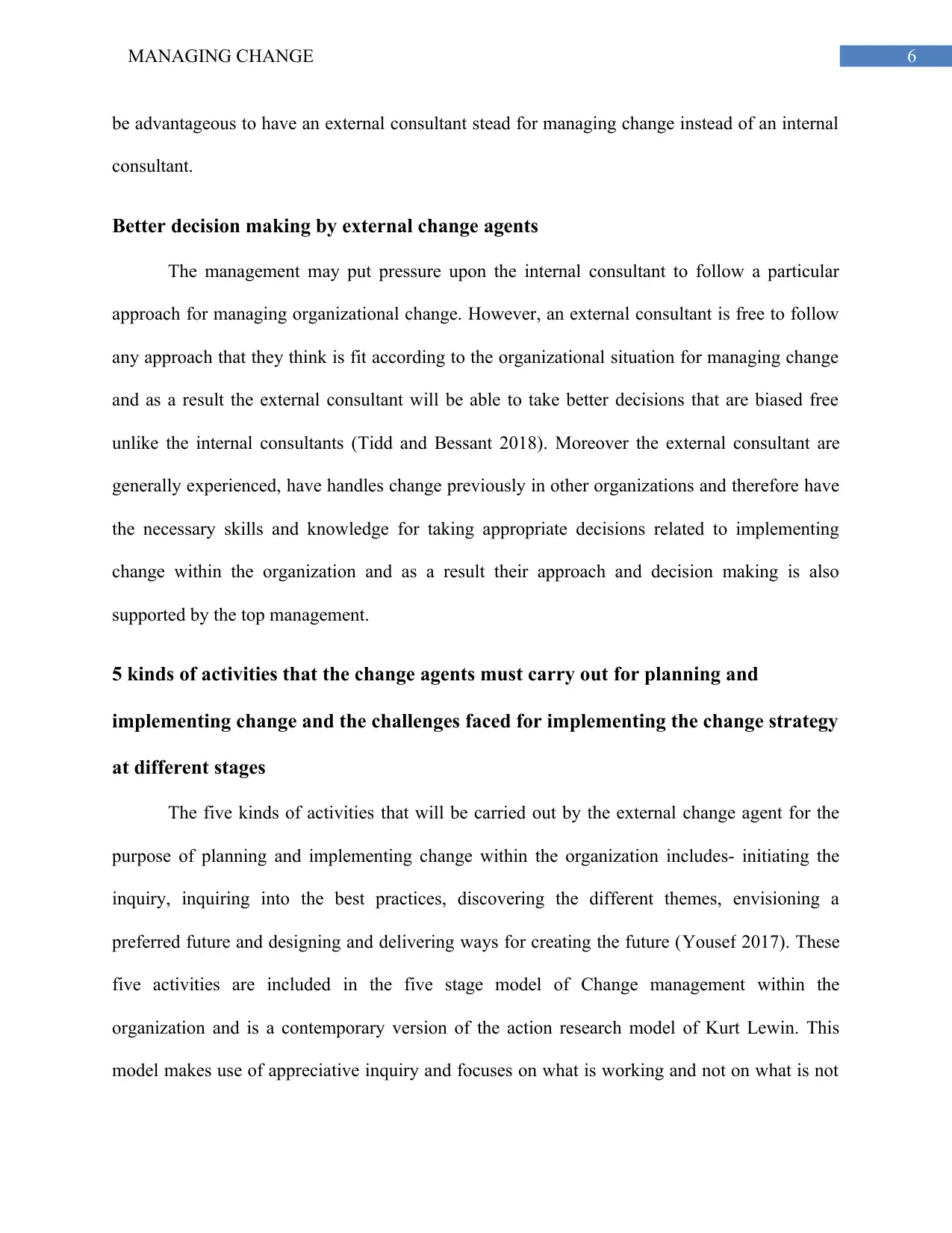
6MANAGING CHANGE
be advantageous to have an external consultant stead for managing change instead of an internal
consultant.
Better decision making by external change agents
The management may put pressure upon the internal consultant to follow a particular
approach for managing organizational change. However, an external consultant is free to follow
any approach that they think is fit according to the organizational situation for managing change
and as a result the external consultant will be able to take better decisions that are biased free
unlike the internal consultants (Tidd and Bessant 2018). Moreover the external consultant are
generally experienced, have handles change previously in other organizations and therefore have
the necessary skills and knowledge for taking appropriate decisions related to implementing
change within the organization and as a result their approach and decision making is also
supported by the top management.
5 kinds of activities that the change agents must carry out for planning and
implementing change and the challenges faced for implementing the change strategy
at different stages
The five kinds of activities that will be carried out by the external change agent for the
purpose of planning and implementing change within the organization includes- initiating the
inquiry, inquiring into the best practices, discovering the different themes, envisioning a
preferred future and designing and delivering ways for creating the future (Yousef 2017). These
five activities are included in the five stage model of Change management within the
organization and is a contemporary version of the action research model of Kurt Lewin. This
model makes use of appreciative inquiry and focuses on what is working and not on what is not
be advantageous to have an external consultant stead for managing change instead of an internal
consultant.
Better decision making by external change agents
The management may put pressure upon the internal consultant to follow a particular
approach for managing organizational change. However, an external consultant is free to follow
any approach that they think is fit according to the organizational situation for managing change
and as a result the external consultant will be able to take better decisions that are biased free
unlike the internal consultants (Tidd and Bessant 2018). Moreover the external consultant are
generally experienced, have handles change previously in other organizations and therefore have
the necessary skills and knowledge for taking appropriate decisions related to implementing
change within the organization and as a result their approach and decision making is also
supported by the top management.
5 kinds of activities that the change agents must carry out for planning and
implementing change and the challenges faced for implementing the change strategy
at different stages
The five kinds of activities that will be carried out by the external change agent for the
purpose of planning and implementing change within the organization includes- initiating the
inquiry, inquiring into the best practices, discovering the different themes, envisioning a
preferred future and designing and delivering ways for creating the future (Yousef 2017). These
five activities are included in the five stage model of Change management within the
organization and is a contemporary version of the action research model of Kurt Lewin. This
model makes use of appreciative inquiry and focuses on what is working and not on what is not
Paraphrase This Document
Need a fresh take? Get an instant paraphrase of this document with our AI Paraphraser
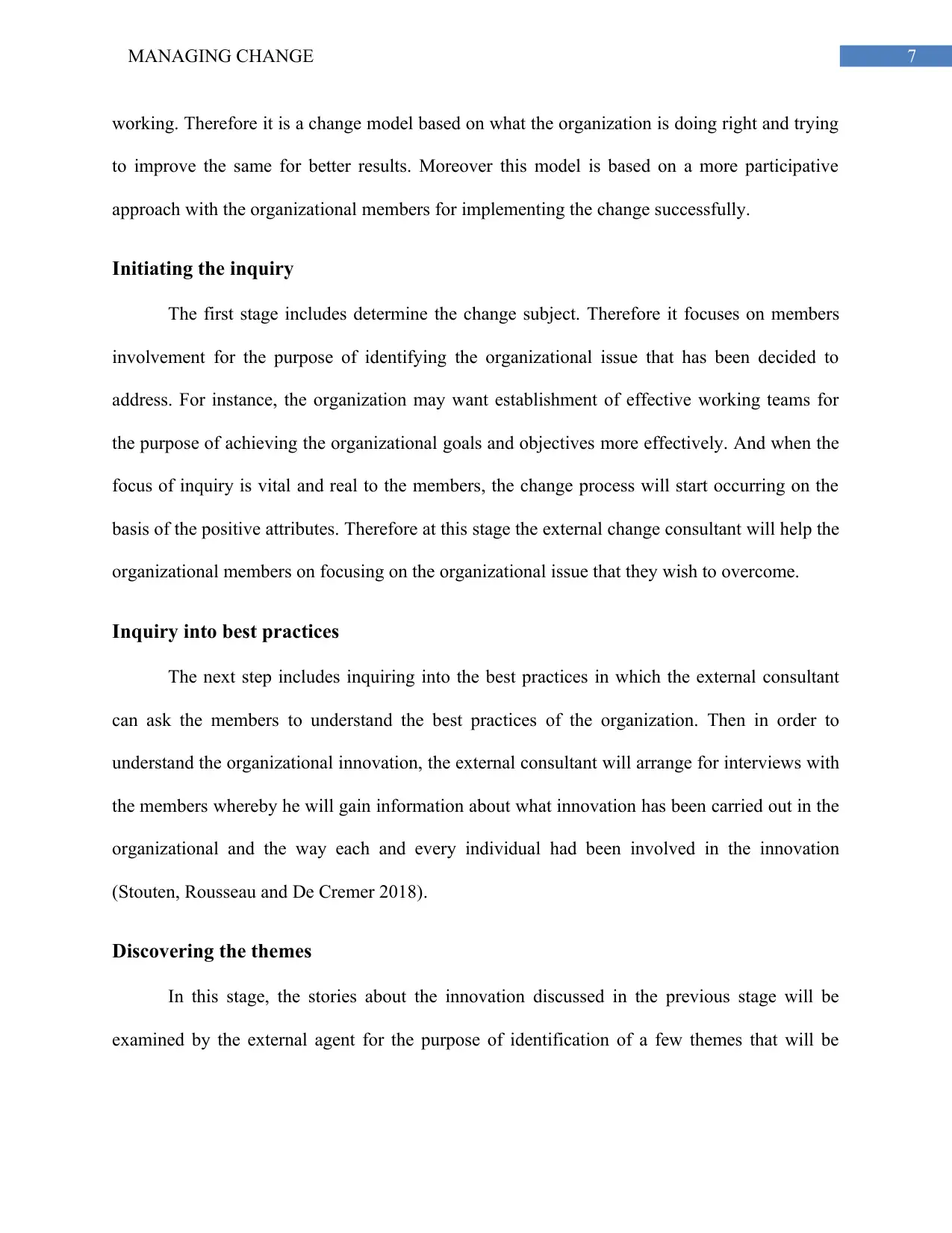
7MANAGING CHANGE
working. Therefore it is a change model based on what the organization is doing right and trying
to improve the same for better results. Moreover this model is based on a more participative
approach with the organizational members for implementing the change successfully.
Initiating the inquiry
The first stage includes determine the change subject. Therefore it focuses on members
involvement for the purpose of identifying the organizational issue that has been decided to
address. For instance, the organization may want establishment of effective working teams for
the purpose of achieving the organizational goals and objectives more effectively. And when the
focus of inquiry is vital and real to the members, the change process will start occurring on the
basis of the positive attributes. Therefore at this stage the external change consultant will help the
organizational members on focusing on the organizational issue that they wish to overcome.
Inquiry into best practices
The next step includes inquiring into the best practices in which the external consultant
can ask the members to understand the best practices of the organization. Then in order to
understand the organizational innovation, the external consultant will arrange for interviews with
the members whereby he will gain information about what innovation has been carried out in the
organizational and the way each and every individual had been involved in the innovation
(Stouten, Rousseau and De Cremer 2018).
Discovering the themes
In this stage, the stories about the innovation discussed in the previous stage will be
examined by the external agent for the purpose of identification of a few themes that will be
working. Therefore it is a change model based on what the organization is doing right and trying
to improve the same for better results. Moreover this model is based on a more participative
approach with the organizational members for implementing the change successfully.
Initiating the inquiry
The first stage includes determine the change subject. Therefore it focuses on members
involvement for the purpose of identifying the organizational issue that has been decided to
address. For instance, the organization may want establishment of effective working teams for
the purpose of achieving the organizational goals and objectives more effectively. And when the
focus of inquiry is vital and real to the members, the change process will start occurring on the
basis of the positive attributes. Therefore at this stage the external change consultant will help the
organizational members on focusing on the organizational issue that they wish to overcome.
Inquiry into best practices
The next step includes inquiring into the best practices in which the external consultant
can ask the members to understand the best practices of the organization. Then in order to
understand the organizational innovation, the external consultant will arrange for interviews with
the members whereby he will gain information about what innovation has been carried out in the
organizational and the way each and every individual had been involved in the innovation
(Stouten, Rousseau and De Cremer 2018).
Discovering the themes
In this stage, the stories about the innovation discussed in the previous stage will be
examined by the external agent for the purpose of identification of a few themes that will be
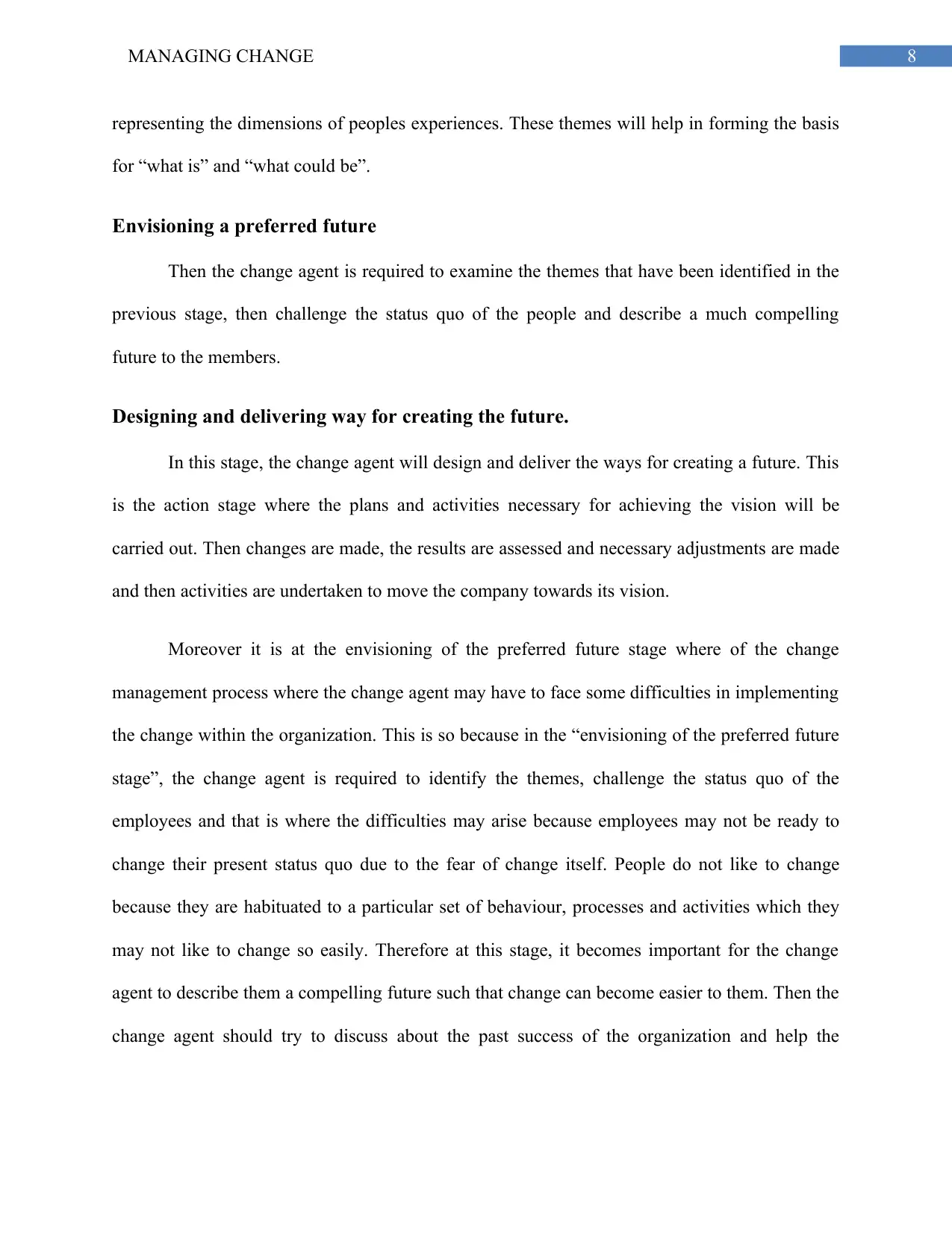
8MANAGING CHANGE
representing the dimensions of peoples experiences. These themes will help in forming the basis
for “what is” and “what could be”.
Envisioning a preferred future
Then the change agent is required to examine the themes that have been identified in the
previous stage, then challenge the status quo of the people and describe a much compelling
future to the members.
Designing and delivering way for creating the future.
In this stage, the change agent will design and deliver the ways for creating a future. This
is the action stage where the plans and activities necessary for achieving the vision will be
carried out. Then changes are made, the results are assessed and necessary adjustments are made
and then activities are undertaken to move the company towards its vision.
Moreover it is at the envisioning of the preferred future stage where of the change
management process where the change agent may have to face some difficulties in implementing
the change within the organization. This is so because in the “envisioning of the preferred future
stage”, the change agent is required to identify the themes, challenge the status quo of the
employees and that is where the difficulties may arise because employees may not be ready to
change their present status quo due to the fear of change itself. People do not like to change
because they are habituated to a particular set of behaviour, processes and activities which they
may not like to change so easily. Therefore at this stage, it becomes important for the change
agent to describe them a compelling future such that change can become easier to them. Then the
change agent should try to discuss about the past success of the organization and help the
representing the dimensions of peoples experiences. These themes will help in forming the basis
for “what is” and “what could be”.
Envisioning a preferred future
Then the change agent is required to examine the themes that have been identified in the
previous stage, then challenge the status quo of the people and describe a much compelling
future to the members.
Designing and delivering way for creating the future.
In this stage, the change agent will design and deliver the ways for creating a future. This
is the action stage where the plans and activities necessary for achieving the vision will be
carried out. Then changes are made, the results are assessed and necessary adjustments are made
and then activities are undertaken to move the company towards its vision.
Moreover it is at the envisioning of the preferred future stage where of the change
management process where the change agent may have to face some difficulties in implementing
the change within the organization. This is so because in the “envisioning of the preferred future
stage”, the change agent is required to identify the themes, challenge the status quo of the
employees and that is where the difficulties may arise because employees may not be ready to
change their present status quo due to the fear of change itself. People do not like to change
because they are habituated to a particular set of behaviour, processes and activities which they
may not like to change so easily. Therefore at this stage, it becomes important for the change
agent to describe them a compelling future such that change can become easier to them. Then the
change agent should try to discuss about the past success of the organization and help the
⊘ This is a preview!⊘
Do you want full access?
Subscribe today to unlock all pages.

Trusted by 1+ million students worldwide
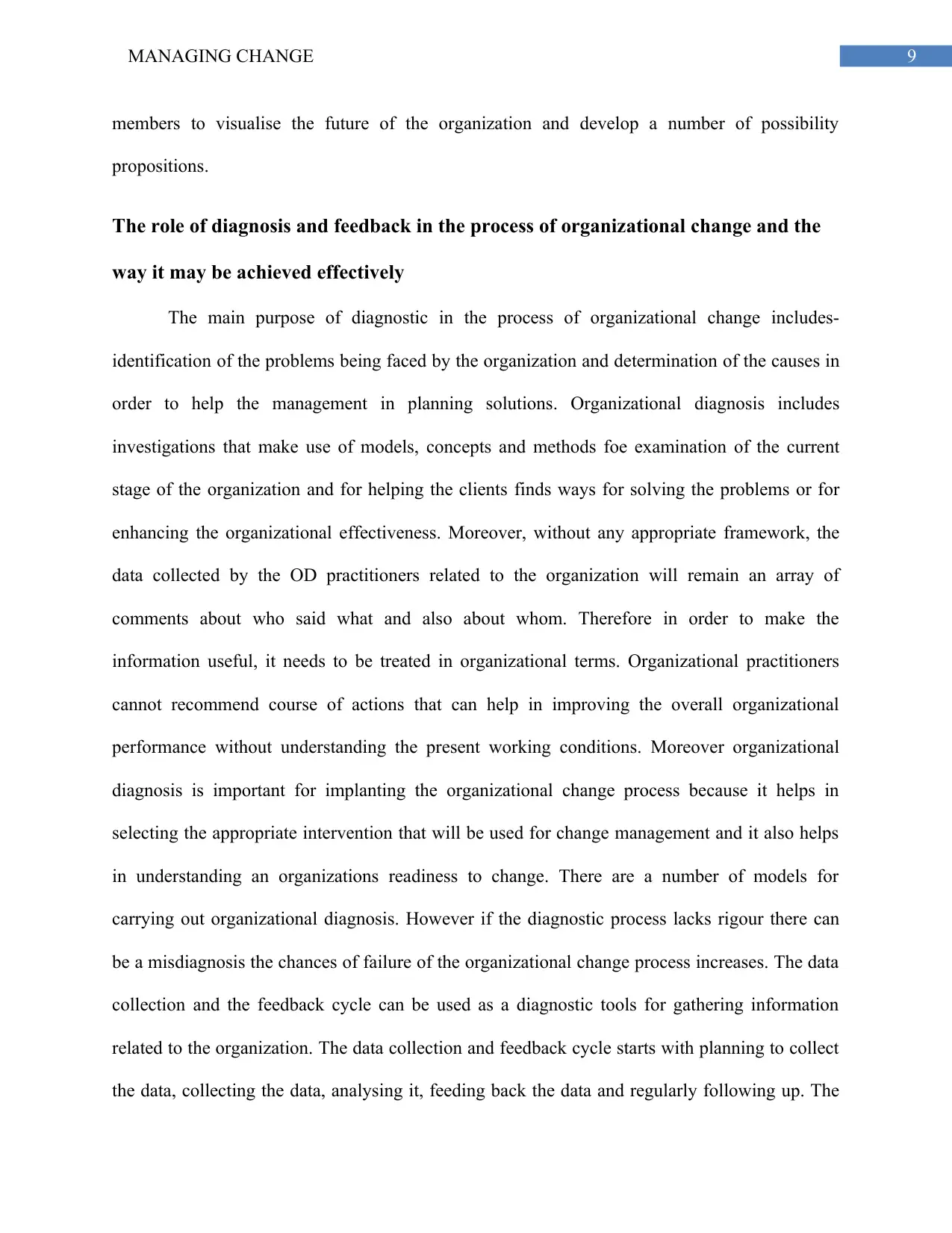
9MANAGING CHANGE
members to visualise the future of the organization and develop a number of possibility
propositions.
The role of diagnosis and feedback in the process of organizational change and the
way it may be achieved effectively
The main purpose of diagnostic in the process of organizational change includes-
identification of the problems being faced by the organization and determination of the causes in
order to help the management in planning solutions. Organizational diagnosis includes
investigations that make use of models, concepts and methods foe examination of the current
stage of the organization and for helping the clients finds ways for solving the problems or for
enhancing the organizational effectiveness. Moreover, without any appropriate framework, the
data collected by the OD practitioners related to the organization will remain an array of
comments about who said what and also about whom. Therefore in order to make the
information useful, it needs to be treated in organizational terms. Organizational practitioners
cannot recommend course of actions that can help in improving the overall organizational
performance without understanding the present working conditions. Moreover organizational
diagnosis is important for implanting the organizational change process because it helps in
selecting the appropriate intervention that will be used for change management and it also helps
in understanding an organizations readiness to change. There are a number of models for
carrying out organizational diagnosis. However if the diagnostic process lacks rigour there can
be a misdiagnosis the chances of failure of the organizational change process increases. The data
collection and the feedback cycle can be used as a diagnostic tools for gathering information
related to the organization. The data collection and feedback cycle starts with planning to collect
the data, collecting the data, analysing it, feeding back the data and regularly following up. The
members to visualise the future of the organization and develop a number of possibility
propositions.
The role of diagnosis and feedback in the process of organizational change and the
way it may be achieved effectively
The main purpose of diagnostic in the process of organizational change includes-
identification of the problems being faced by the organization and determination of the causes in
order to help the management in planning solutions. Organizational diagnosis includes
investigations that make use of models, concepts and methods foe examination of the current
stage of the organization and for helping the clients finds ways for solving the problems or for
enhancing the organizational effectiveness. Moreover, without any appropriate framework, the
data collected by the OD practitioners related to the organization will remain an array of
comments about who said what and also about whom. Therefore in order to make the
information useful, it needs to be treated in organizational terms. Organizational practitioners
cannot recommend course of actions that can help in improving the overall organizational
performance without understanding the present working conditions. Moreover organizational
diagnosis is important for implanting the organizational change process because it helps in
selecting the appropriate intervention that will be used for change management and it also helps
in understanding an organizations readiness to change. There are a number of models for
carrying out organizational diagnosis. However if the diagnostic process lacks rigour there can
be a misdiagnosis the chances of failure of the organizational change process increases. The data
collection and the feedback cycle can be used as a diagnostic tools for gathering information
related to the organization. The data collection and feedback cycle starts with planning to collect
the data, collecting the data, analysing it, feeding back the data and regularly following up. The
Paraphrase This Document
Need a fresh take? Get an instant paraphrase of this document with our AI Paraphraser
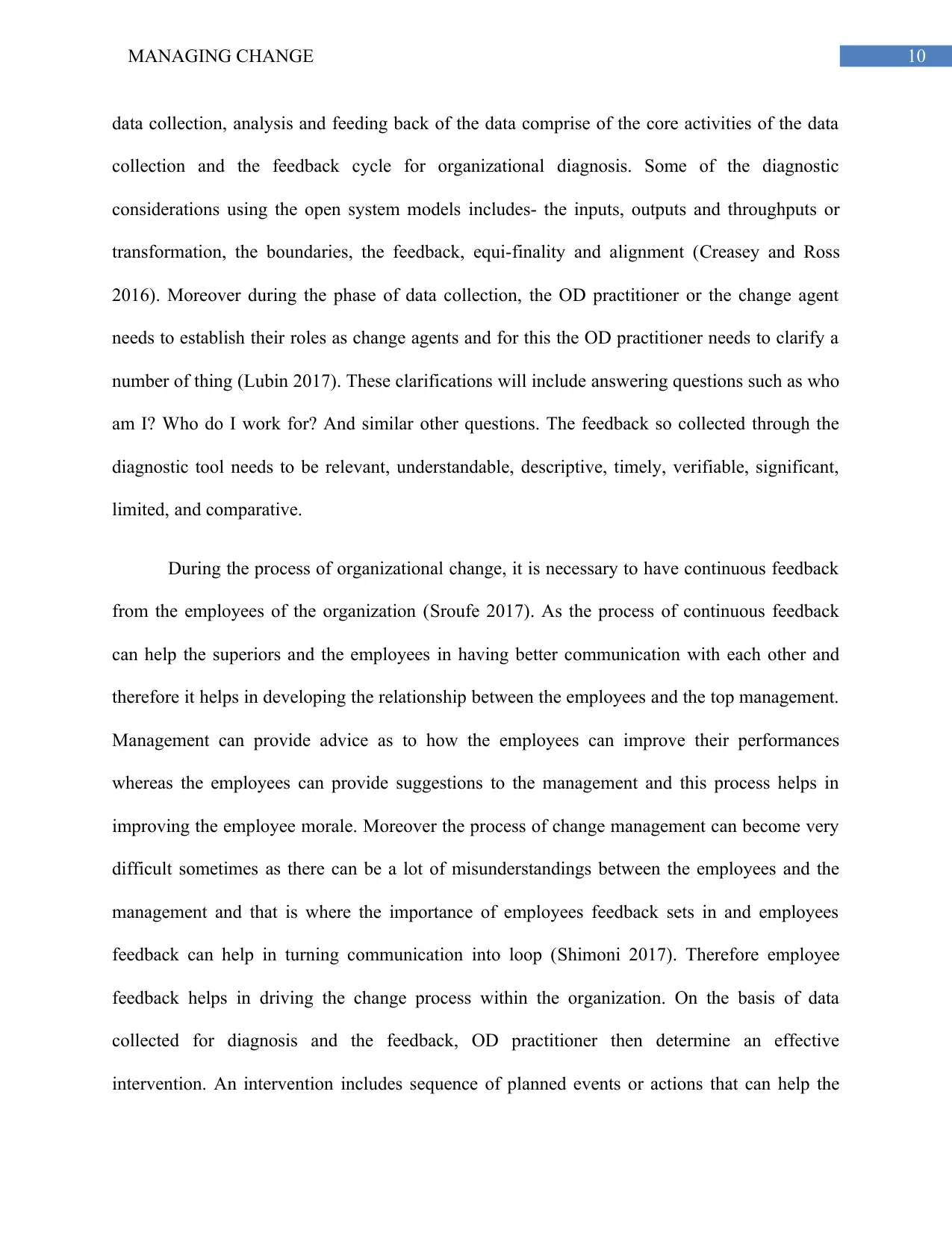
10MANAGING CHANGE
data collection, analysis and feeding back of the data comprise of the core activities of the data
collection and the feedback cycle for organizational diagnosis. Some of the diagnostic
considerations using the open system models includes- the inputs, outputs and throughputs or
transformation, the boundaries, the feedback, equi-finality and alignment (Creasey and Ross
2016). Moreover during the phase of data collection, the OD practitioner or the change agent
needs to establish their roles as change agents and for this the OD practitioner needs to clarify a
number of thing (Lubin 2017). These clarifications will include answering questions such as who
am I? Who do I work for? And similar other questions. The feedback so collected through the
diagnostic tool needs to be relevant, understandable, descriptive, timely, verifiable, significant,
limited, and comparative.
During the process of organizational change, it is necessary to have continuous feedback
from the employees of the organization (Sroufe 2017). As the process of continuous feedback
can help the superiors and the employees in having better communication with each other and
therefore it helps in developing the relationship between the employees and the top management.
Management can provide advice as to how the employees can improve their performances
whereas the employees can provide suggestions to the management and this process helps in
improving the employee morale. Moreover the process of change management can become very
difficult sometimes as there can be a lot of misunderstandings between the employees and the
management and that is where the importance of employees feedback sets in and employees
feedback can help in turning communication into loop (Shimoni 2017). Therefore employee
feedback helps in driving the change process within the organization. On the basis of data
collected for diagnosis and the feedback, OD practitioner then determine an effective
intervention. An intervention includes sequence of planned events or actions that can help the
data collection, analysis and feeding back of the data comprise of the core activities of the data
collection and the feedback cycle for organizational diagnosis. Some of the diagnostic
considerations using the open system models includes- the inputs, outputs and throughputs or
transformation, the boundaries, the feedback, equi-finality and alignment (Creasey and Ross
2016). Moreover during the phase of data collection, the OD practitioner or the change agent
needs to establish their roles as change agents and for this the OD practitioner needs to clarify a
number of thing (Lubin 2017). These clarifications will include answering questions such as who
am I? Who do I work for? And similar other questions. The feedback so collected through the
diagnostic tool needs to be relevant, understandable, descriptive, timely, verifiable, significant,
limited, and comparative.
During the process of organizational change, it is necessary to have continuous feedback
from the employees of the organization (Sroufe 2017). As the process of continuous feedback
can help the superiors and the employees in having better communication with each other and
therefore it helps in developing the relationship between the employees and the top management.
Management can provide advice as to how the employees can improve their performances
whereas the employees can provide suggestions to the management and this process helps in
improving the employee morale. Moreover the process of change management can become very
difficult sometimes as there can be a lot of misunderstandings between the employees and the
management and that is where the importance of employees feedback sets in and employees
feedback can help in turning communication into loop (Shimoni 2017). Therefore employee
feedback helps in driving the change process within the organization. On the basis of data
collected for diagnosis and the feedback, OD practitioner then determine an effective
intervention. An intervention includes sequence of planned events or actions that can help the
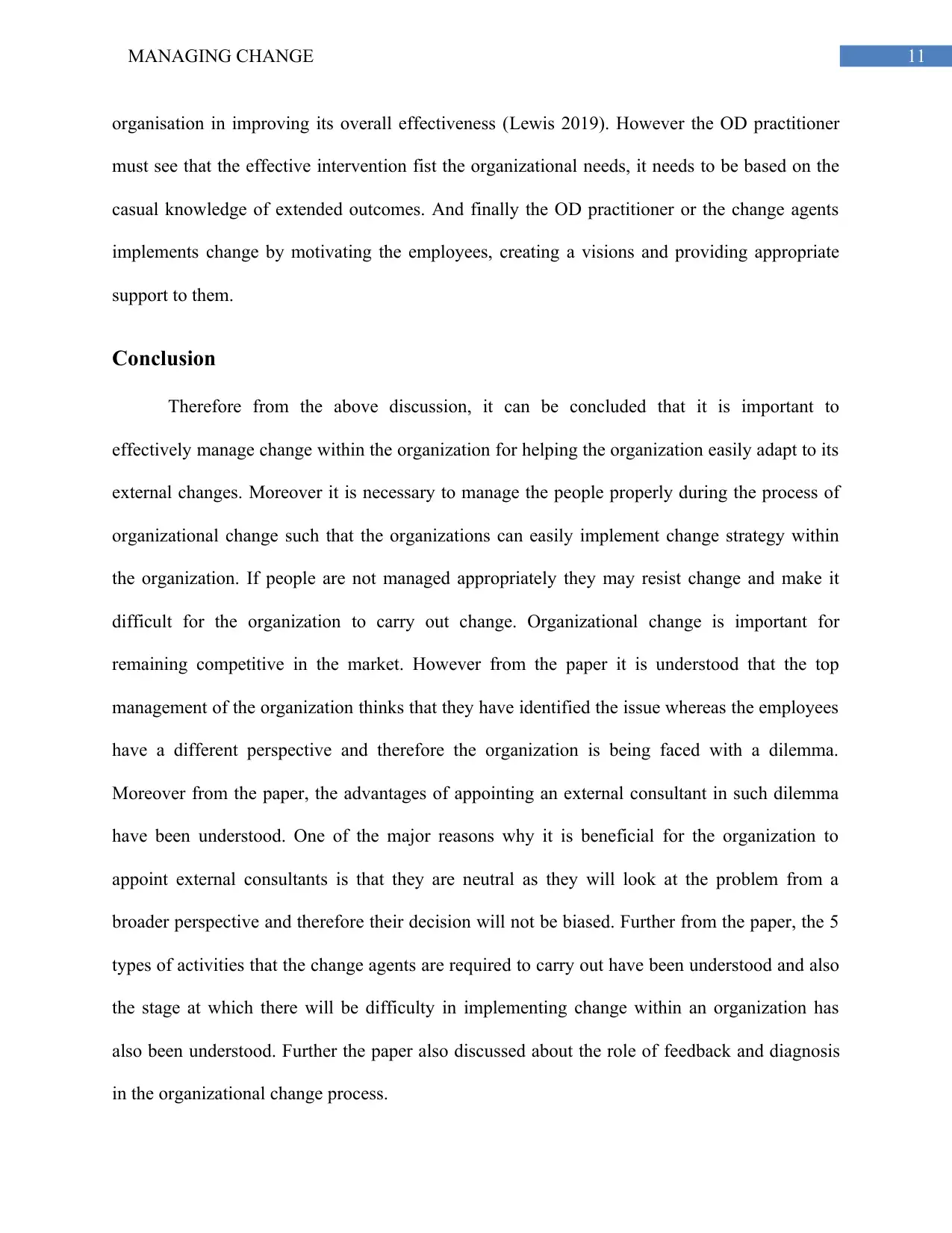
11MANAGING CHANGE
organisation in improving its overall effectiveness (Lewis 2019). However the OD practitioner
must see that the effective intervention fist the organizational needs, it needs to be based on the
casual knowledge of extended outcomes. And finally the OD practitioner or the change agents
implements change by motivating the employees, creating a visions and providing appropriate
support to them.
Conclusion
Therefore from the above discussion, it can be concluded that it is important to
effectively manage change within the organization for helping the organization easily adapt to its
external changes. Moreover it is necessary to manage the people properly during the process of
organizational change such that the organizations can easily implement change strategy within
the organization. If people are not managed appropriately they may resist change and make it
difficult for the organization to carry out change. Organizational change is important for
remaining competitive in the market. However from the paper it is understood that the top
management of the organization thinks that they have identified the issue whereas the employees
have a different perspective and therefore the organization is being faced with a dilemma.
Moreover from the paper, the advantages of appointing an external consultant in such dilemma
have been understood. One of the major reasons why it is beneficial for the organization to
appoint external consultants is that they are neutral as they will look at the problem from a
broader perspective and therefore their decision will not be biased. Further from the paper, the 5
types of activities that the change agents are required to carry out have been understood and also
the stage at which there will be difficulty in implementing change within an organization has
also been understood. Further the paper also discussed about the role of feedback and diagnosis
in the organizational change process.
organisation in improving its overall effectiveness (Lewis 2019). However the OD practitioner
must see that the effective intervention fist the organizational needs, it needs to be based on the
casual knowledge of extended outcomes. And finally the OD practitioner or the change agents
implements change by motivating the employees, creating a visions and providing appropriate
support to them.
Conclusion
Therefore from the above discussion, it can be concluded that it is important to
effectively manage change within the organization for helping the organization easily adapt to its
external changes. Moreover it is necessary to manage the people properly during the process of
organizational change such that the organizations can easily implement change strategy within
the organization. If people are not managed appropriately they may resist change and make it
difficult for the organization to carry out change. Organizational change is important for
remaining competitive in the market. However from the paper it is understood that the top
management of the organization thinks that they have identified the issue whereas the employees
have a different perspective and therefore the organization is being faced with a dilemma.
Moreover from the paper, the advantages of appointing an external consultant in such dilemma
have been understood. One of the major reasons why it is beneficial for the organization to
appoint external consultants is that they are neutral as they will look at the problem from a
broader perspective and therefore their decision will not be biased. Further from the paper, the 5
types of activities that the change agents are required to carry out have been understood and also
the stage at which there will be difficulty in implementing change within an organization has
also been understood. Further the paper also discussed about the role of feedback and diagnosis
in the organizational change process.
⊘ This is a preview!⊘
Do you want full access?
Subscribe today to unlock all pages.

Trusted by 1+ million students worldwide
1 out of 16
Related Documents
Your All-in-One AI-Powered Toolkit for Academic Success.
+13062052269
info@desklib.com
Available 24*7 on WhatsApp / Email
![[object Object]](/_next/static/media/star-bottom.7253800d.svg)
Unlock your academic potential
Copyright © 2020–2025 A2Z Services. All Rights Reserved. Developed and managed by ZUCOL.





